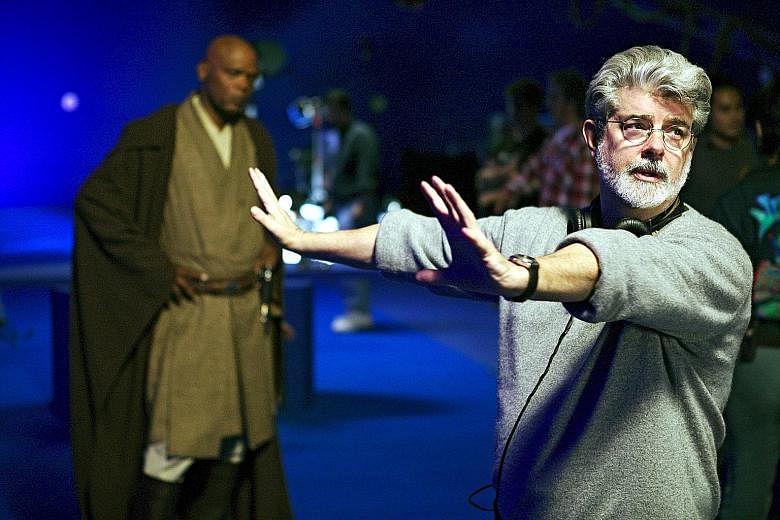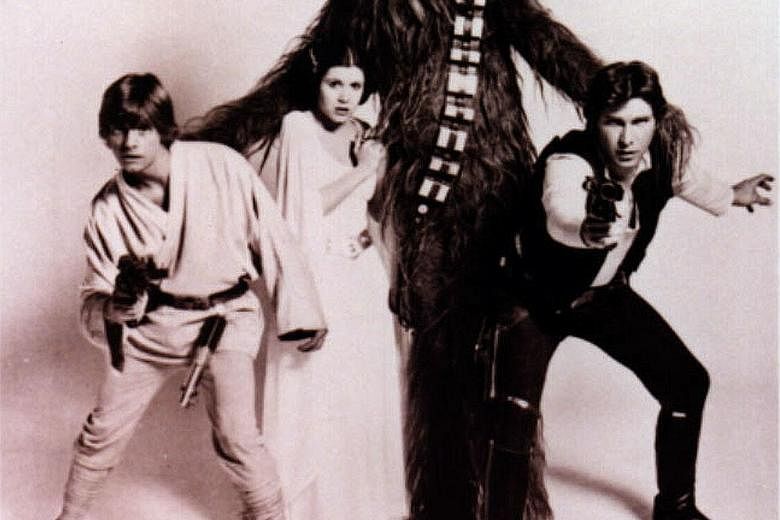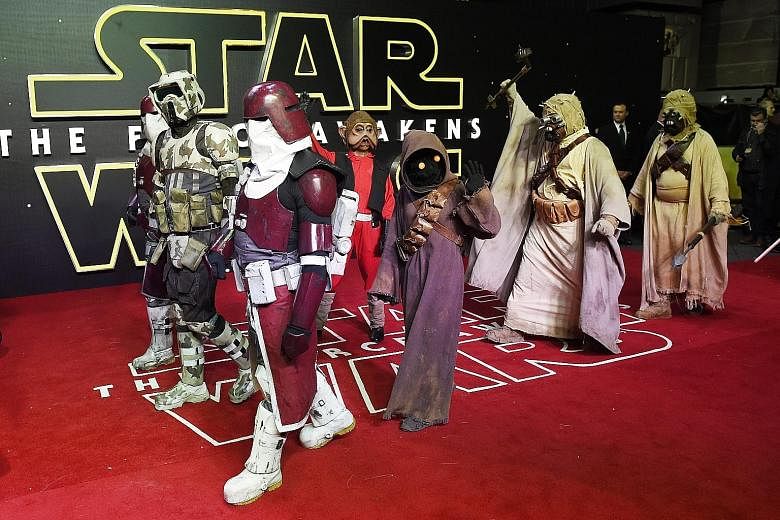It is the most eagerly awaited movie of this year. For Disney it is not just the box-office numbers that count but the billion-dollar licensing deals, which could make Star Wars: The Force Awakens the biggest movie of all time.
In the summer of 1977, images of thousands of cinemagoers queueing to see Star Wars at Mann's Chinese Theater in Hollywood became emblematic of the film's surprise success. Almost four decades on, the fans are back, camping out days ahead of the release of Star Wars: The Force Awakens.
Expectations were so low for the first movie that it initially opened on 42 screens. The new episode is being released in thousands of cinemas worldwide.
That is not the only thing to have changed in the intervening years: Han Solo and Princess Leia are older and greyer and Star Wars is now owned by Walt Disney, following its US$4 billion (about S$5.7 billion) acquisition of Lucasfilm in 2012.
The Force Awakens is the first of six new Star Wars films commissioned by Disney with the potential to generate billions of dollars at the box office. But Disney's ambitions go far beyond the big screen.
CASH MACHINE
As George Lucas proved in 1977 when he agreed to waive a portion of his salary for directing the film in exchange for merchandising rights, Star Wars is a cash machine. Toy sales alone made Lucas a billionaire and, nearly 40 years on, Disney has lined up a bewildering array of global merchandising opportunities - from action figures to advent calendars, lightsabers to Lego - for its revival of the franchise. The most in-demand Christmas gift this year is BB8, a mini-droid toy that can be controlled using a smartphone or tablet.
Calculating the revenues generated from sales of Star Wars products is difficult but Mr Tim Nollen at Macquarie Securities estimates that, based on other releases, the figure could exceed US$5 billion even before DVD sales are factored in. Brands usually negotiate royalty rates of between 6 per cent and 7 per cent when licensing their intellectual property for consumer products, but Disney has secured rates as high as 20 per cent on some of its new Star Wars deals, according to people familiar with the matter. Mr Nollen estimates that Disney could generate US$500 million to US$1 billion in revenues from licensing arrangements for The Force Awakens, a figure that suggests the company got a bargain when it bought Lucasfilm.
"George Lucas arguably sold Star Wars for too little," says Mr Rich Greenfield, an analyst with BTIG Research. "When you know what Disney can do with it, it seems to me that it is worth a lot more than US$4 billion."
It is doubtful that any other media company would have been able to exploit the Star Wars franchise as effectively as Disney. It owns and operates global theme parks, America's largest sports cable network in ESPN, the ABC broadcast network, cable channels and a consumer products division which generated US$1.7 billion in operating income alone in its 2015 fiscal year. This means it can squeeze bigger returns from its movies and over a longer period than peers such as Time Warner and 21st Century Fox.
As it demonstrated with Frozen, its animated Oscar winner from 2013, the release of one of its movies is just the starting point for myriad other Disney-owned or licensed businesses. Frozen generated more than US$1 billion in revenues from the sale of books, games, outfits and dolls, while the film's soundtrack beat Taylor Swift's "1989" and Beyonce's "Beyonce" to be the biggest-selling album last year.
Because there is already a sizeable fan base for The Force Awakens, analysts say the film could have an even bigger merchandising impact. Disney will also open two new Star Wars-themed "lands" at its amusement parks in California and Florida - designed to capitalise on the new release.
"No other company can monetise a piece of content as efficiently as Disney," says Mr Anthony DiClemente, an analyst with Nomura Securities. The Force Awakens "is going to be the biggest example of that in the history of the company".
The cross-promotion opportunities are huge. Harrison Ford, Carrie Fisher and the rest of the film's cast have been guests on morning and late-night chat shows that air on the ABC network, while the hotly anticipated final trailer for the film was premiered on ESPN. For anyone who missed all that, Mark Hamill, who plays Luke Skywalker, on Tuesday hosted a documentary screened on ESPN about the use of martial arts in the films' many lightsabre duels. "It is about time that (Kendo)gets some long-overdue recognition," he says in the promotional blurb to accompany the movie.
The release of The Force Awakens comes at a testing time for other parts of Disney. Its media networks division, which generates more than half of Disney's profits, is grappling with changes in consumer viewing patterns that have rattled the entire media sector. Disney's media networks, which include ESPN, ABC and the Disney Channel, earned US$7.8 billion in operating income in the 2015 fiscal year - more than half of the company's profits.
Disney does not break down the performance of its individual networks but the lion's share of media networks' income comes from ESPN. On its most recent earnings call, it said profits at the sports cable network were higher than the previous year's. However, the network lost three million subscribers in the 12 months to August, according to Nielsen, the research firm. Fears of "cord-cutting" - the cancellation of cable or satellite subscriptions in favour of streaming services such as Netflix - have consumed US media companies this year, culminating in a steep, sector-wide fall in August.
Disney was the catalyst for that tumble when it warned of "modest subscriber losses" at ESPN: its shares fell more than 20 per cent over three weeks, although they have since rallied.
Concerns about cord-cutting have not gone away. ESPN commands the highest fees in the industry from cable and satellite companies, which pay handsomely to carry its network, and has been able to increase the amount it charges those distributors in recent years. But that fee growth is under pressure: fewer subscribers means ESPN cannot keep hiking the fees it charges cable and satellite operators. Income from fees at Disney's media networks division rose more than 10 per cent in the third quarter of this year but growth slipped to 8 per cent in the fourth quarter and is projected to fall again, to the range of 4 per cent to 5 per cent, in the first quarter of next year, according to Mr Todd Juenger, an analyst with Bernstein Research.
Analysts expect US opening-weekend takings for The Force Awakens to rival or even beat the US$208 million record set this summer by Universal's Jurassic World, with estimates ranging from US$180 million to US$250 million. More than US$50 million of advance tickets have been sold already - 12 times as many as were bought for this year's other big hit, another Disney release, The Avengers: Age Of Ultron, according to Mr Joel Cohen, chief executive of MovieTickets.com.
"In the 15 years that we've been doing this, it's by far the most interest that we've seen in any film," he says.
GLOBAL EXPECTATIONS
Unlike earlier Star Wars movies, The Force Awakens, which cost around US$200 million to produce, will be released into a more globalised film market.
A multiplex boom in China has put the country on course to overtake the US as the world's largest movie market by number of screens and box-office revenue within two years, according to Mr Rich Gelfond, chief executive of Imax, the big-screen cinema group.
The hype has been building steadily for more than a year, so much of the expectation about The Force Awakens' earnings potential is already reflected in the company's share price, says Mr Greenfield. Shares have risen more than 63 per cent over the past two years, valuing Disney at more than US$180 billion.
"People have very high expectations," he says. "It needs to be a massive hit."
Avatar remains the highest-grossing movie with US$2.8 billion.
Could The Force Awakens be the first US$3 billion film? Disney has not commented on what it expects but the vast marketing campaign suggests it has high hopes. In the US, the company has struck "strategic promotional partnerships" with seven big brands, including Fiat Chrysler, Subway and Verizon. In Japan, it agreed a deal with All Nippon Airways which resulted in three Star Wars "wrapped" aircraft. In Britain, a special set of stamps was commissioned to mark the launch of the film; in China, the movie's trailer was played on the Great Wall while 500 stormtroopers stood guard.
Amid the marketing hype, cross promotion and commercial synergies, one factor alone will determine its success. "The most important thing is: Is it a great movie?" says Mr Paul Dergarabedian, a senior analyst with Rentrak, which analyses box-office performance.
If it is, Disney could have a hit on its hands the like of which Hollywood has never seen before.
THE FINANCIAL TIMES



